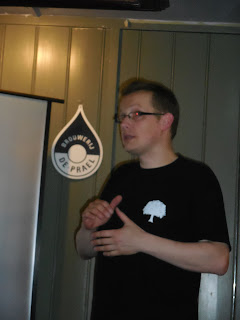I arrived in Amsterdam in time for the opening event at Oedipus Brewery. You have to take a short ferry ride from the Central Station to get there, but the ferry's free and frequent so it wasn't a problem. In many ways the Dutch are very civilised.
 |
| The Kropotkin look proved popular amongst attendees |
Jean Van Roy talked of the remarkable turnaround that sour beer has had in the course of his brewing career. When he started Cantillon were brewing less than 500hl a year and he had to fight to sell any beer, now people are fighting to buy it! Since taking over as head brewer he has changed the production process slightly, in that barrels are now topped up so less beer is exposed to air and less acid is produced. He also talked about how they try to make the brewery as green as possible. As they can only brew when weather is too hot global warming has cut their brewing season by nearly two months a year since he started brewing.
Chad Yakobson brews a range of beer using Brettanomyces, some sour and some not. The Brettanomyces Project came from work he did on the Masters degree course at Heriot-Watt. He's built up the cultures he brews with commercially over time and currently has two mixed cultures on the go. He also brews some 'clean' beers with Saccharomyces.
Yvan De Baets brewed at Cantillon at one point, but when he started his own brewery only 5km didn't see the point of making sour beer himself. He has now started to use Brettanomyces, but adding complexity this way takes time. He mentioned that back in 1921 a Belgian brewing journal reported that cultured yeasts have simplified beer, and thinks that in the future people will look for local yeasts to add complexity. He's isolated a local strain of Brett. that he uses in a saison beer.
All three of the speakers agreed that brewing combines science and art, each informing the other.
My own talk on The Brewing Science of Brettanomyces was the next day, which I'll get round to writing up shortly. Though probably not before my next climbing trip. If anyone wants the slides drop me a line.
The next speaker I saw was Pierre Tilquin, who founded his own Gueuze blending company Gueuzerie Tilquin. It's not a cheap things to do, as it cost €500,00 and production is currently 800hl a year. He buys in wort from Boon, Cantillon, Lindemans, and Giardin. He makes his gueuze by blending 50% one year old beer with 30% two year old and 20% three year old. He found some lambics age better than others; and some will attenuate to 100% apparent attenuation, whereas others will conk out at 75%. It was also interesting to hear that some lambic wort comes in at pH5 whereas others are at pH4. It confirms a point about lactic acid if you ask me, but Pierre was too diplomatic to say so.
There were no more talks for me that day, as I'd met up with Geoff from Popes Yard brewery and was off sampling his excellent wares at In De Wilderman. I also got to touch Colin from Buxton brewery there. A slightly odd innovation for the Carnivale Brettanomyces was moving on from the common or garden 'meet the brewer' to 'touch the brewer'. Maybe it's an Amsterdam thing.
Anyway, he didn't take offence when a stranger walked up and gratuitously touched him.
The next morning Chad Yakobson was giving a talk which I couldn't miss.
He talked about The Brettanomyces Project, Brettanomyces in general and Crooked Stave brewery. It was a comprehensive talk and I managed to add a few more fascinating facts to my Brettanomyces collection. Some of the alpha-glucosidase Brett. produces is extra-cellular, which explains the rise in glucose he found in some of his fermentations for The Brettanomyces Project. As he makes sour mixed culture, Brettanomyces, and 'clean' beers he has three separate colour coded sets of hoses, valves, pipes, packaging equipment and fermenters.
After Chad's talk I hot footed it back to De Prael to see Ron on Stock Ales.
His latest collaboration brew is a stock ale made with Goose Island, and there was a short introduction from their Innovation brewer. Ron followed by talking about the historic difference between mild ales and stock ales. They basically had the same recipe but stock ales had 50% more hops and were aged. Bass used to age their beer in barrels for a year, where they'd reach over 90% attenuation whereas many beers at the time had 75% or less.
The Goose Island stock ale called 'Brewery Yard' was pitched with B.claussenii after primary fermentation and aged in barrels for 11 months. It had an OG of 1067 and an ABV of 7.3%. The IBUs were 95 before ageing and 62 after. We did get to try some, and it was reminiscent of McCrorie IPA.
Then there was a home brewers event and I'd brought along a few bottles of various bretty beers I'd made, admittedly not all at home, to share out and Geoff was kind enough to share some of his Keeping Porter.
After that I went to De Bierkoning to get some more of Eddie Gadd's gorgeous bretted IPA. I also blagged a T-shirt off one of the organisers, which was only fair said the judge. Then it was back to the wildeman where my higher functions slowly closed down over the course of the evening until it was time for my spinal cord to take me back to the hotel.
That was it for me with the Brett. fest, though my flight wasn't till half one so I had time to take in some of the sights of Amsterdam before heading home.






Great write up Ed!
ReplyDelete